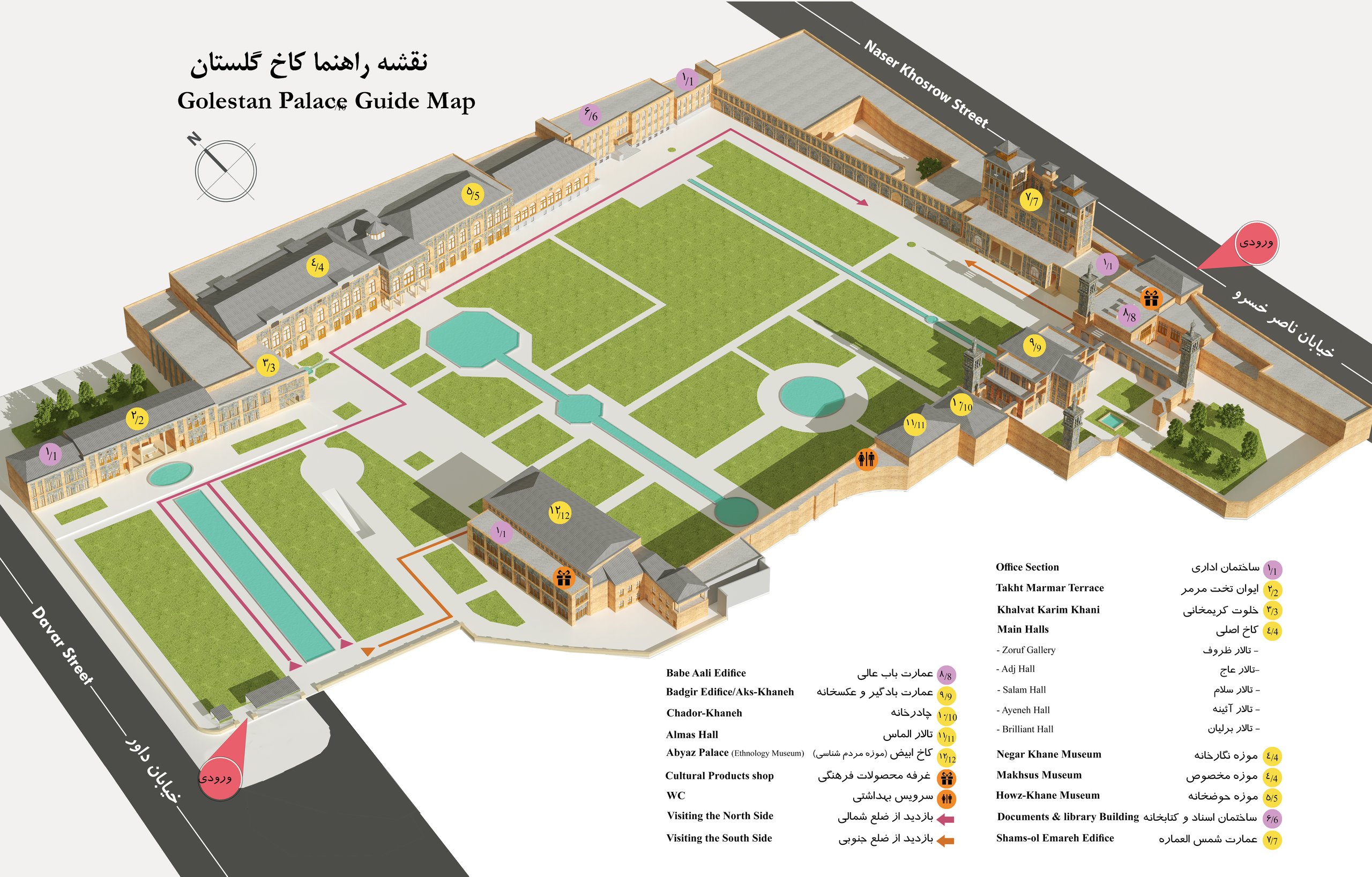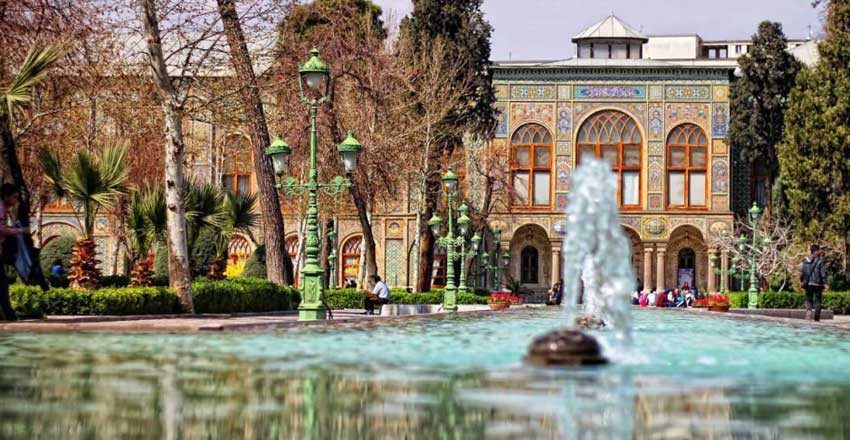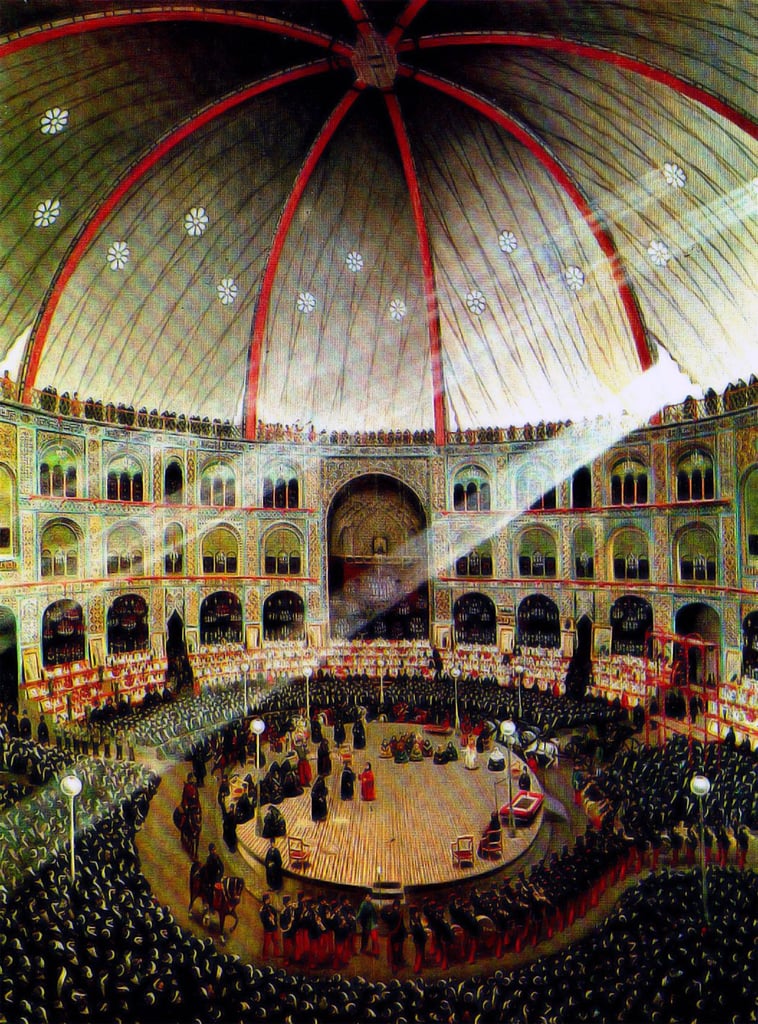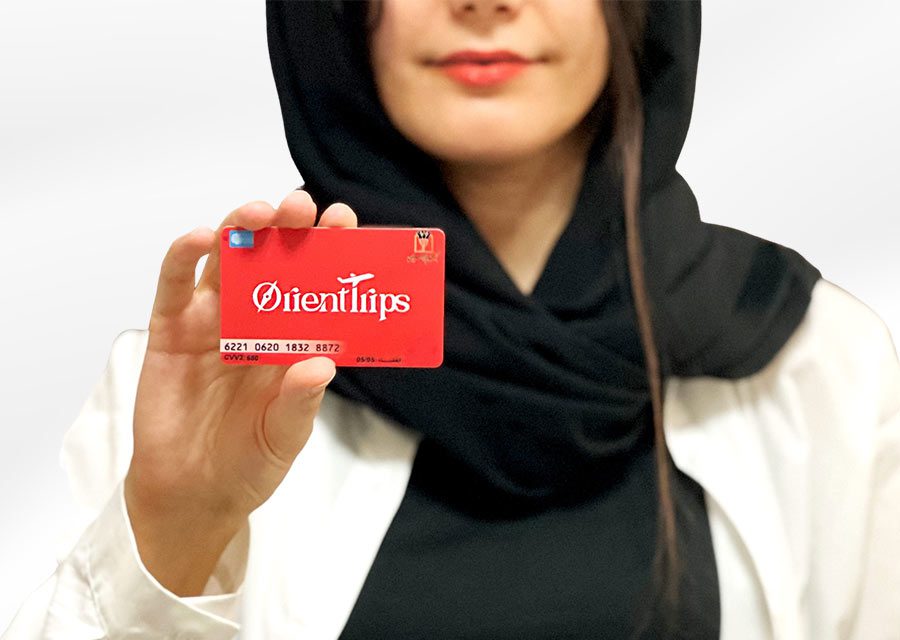Golestan Palace: A Jewel of Tehran’s History
Key Attractions, Practical Advice, and Photo Highlights of Golestan Palace

Discover the majestic Golestan Palace, a historic masterpiece located in the heart of Tehran. This UNESCO World Heritage site blends Persian craftsmanship with Western influences, showcasing opulent halls, intricate mosaics, and lush gardens.
A symbol of Iran’s rich cultural heritage, Golestan Palace invites travelers to explore its storied past and architectural marvels. Visit SURFIRAN Tours to plan your journey to this iconic landmark and experience the essence of Persian history and artistry.
Contents
Where is Golestan Palace Located?
Before diving into the wonders of Golestan Palace, let’s pinpoint its location. Located in the heart of Tehran, this iconic site is situated in the bustling market area. You’ll find Golestan Palace on Panzdeh Khordad Street, extending eastward to Nasser Khosro Street.
Address: 15 Khordad St., north of Arg Square
This central location makes Golestan Palace easily accessible and a must-visit spot for those exploring the capital’s rich history and culture.
Accessing Golestan Palace by Subway
The most convenient way to visit this historical marvel is by subway. For a hassle-free journey to Golestan Palace, take line 1 of the Tehran metro and alight at the 15 Khordad station. From there, a brief 5-minute walk towards Panzdeh Khordad Square will lead you directly to the palace. Simply head east from Davar Street, and you’ll arrive at the grand entrance of Golestan Palace. Utilize the Tehran metro guide for an easy and efficient route to this must-see destination.
Reaching Golestan Palace by Bus
Alternatively, buses offer another practical route to Golestan Palace. Opt for the BRT lines that stop at Golobandak station. From here, a short walk will take you to the gates of the Golestan Palace complex and museum.
Accessing Golestan Palace by Taxi
Geographically, Golestan Palace is positioned in a prime location, making it easily accessible by various modes of public transportation. Opting for a taxi is a convenient way to visit this historic site. You can easily find taxis heading to Golobandak intersection throughout Tehran. These taxis are available at key locations such as Fatemi Square, Enghelab Square, Sadeqieh Second Square, Jomhouri Street, and more.
Golestan Palace Map
Explore the Golestan Palace with this detailed map, guiding you through its historical halls, lush gardens, and intricate architecture. A perfect tool for planning your visit to this iconic landmark.

Visiting Conditions
Golestan Palace is a living testament to nearly 500 years of Iran’s history. It’s an extraordinary masterpiece crafted by the hands of skilled artisans, painters, and architects who spent years of their lives building this massive structure. It served as the residence and ruling seat of the Qajar and Pahlavi shahs, sprawling over an area of 4.5 hectares.
Throughout the year, this noble abode, which once served monarchs like Agha Mohammad Khan, Fath-Ali Shah, Naser al-Din Shah, Mozaffar ad-Din Shah, and Ahmad Shah Qajar, remains open to visitors.
However, it’s closed on occasions like the death anniversaries of Prophet Muhammad and Imam Hassan Mojtaba, the martyrdom of Imam Ali (the first Shia Imam), Tasu’a and Ashura of Hussein, Arba’een, the martyrdom of Imam Jafar Sadiq, the death anniversary of Imam Khomeini, and also on March 13, the Nature Day.
During Nowruz (Persian New Year) and summer, you’ll likely encounter the busiest days, so autumn and winter might be better options for a visit. Although you will still find crowds during these times, they are relatively less than other periods.
In the first half of the year, the doors open at 9:30 am and close at 6:30 pm. In the second half, the grounds open to visitors from 9.00 am with ticket sales continuing until 5:30 pm, and closing time remains the same.
We recommend dedicating a full day, from opening to closing hours, to explore this magnificent palace. With various sections to see, rest assured it will never bore you, constantly presenting you with fascinating sights. If you’re accompanied by a tour leader or guide, you’ll hear real and captivating stories.
History of the Golestan Palace

The story of Tehran’s royal citadel, Golestan Palace, dates back to an intriguing episode on July 6, 1404. Ruy González de Clavijo, an envoy of King Enrique III, visited Samarkand and chose to stay at the residence of Baba Sheikh, a respected elder in Tehran. This site, believed to be in the area of the current palace, evolved significantly over time.
The initial stages of the royal citadel trace back to Suleiman I’s reign, marked by the construction of a palace in the Chenaristan area. This site also hosted a significant meeting between Sultan Hoseyn and Ottoman envoy Ahmad Dari Effendi. Tehran’s arg, or citadel, began to take shape under the Safavid dynasty’s Tahmasp I (1524–1576).
Abbas the Great later added a vast garden to the northern part of the citadel, enclosing it with high walls and new buildings, including the royal residence. By the end of the Safavid era, Tehran had become a temporary seat for Safavid kings. The palace underwent further transformations under Karim Khan of the Zand dynasty (1750–1779).
The pivotal moment came with Agha Mohammad Khan of the Qajar dynasty (1742–1797), who declared Tehran his capital. The arg then became the Qajars’ seat of power (1794–1925), with the palace evolving into the official residence of the dynasty. A significant reconstruction in 1865 by Haji Ab ol Hasan Mimar Navai gave the palace its present form.
During the Pahlavi era (1925–1979), Golestan Palace served as the venue for formal royal receptions, while the Pahlavis built the Niavaran Complex as their primary residence. Key events here included the coronations of Reza Shah and Mohammad Reza Pahlavi. However, Reza Shah ordered the demolition of a large part of the complex between 1925 and 1945, paving the way for modern commercial buildings that echoed the architectural styles of the 1950s and 1960s. This decision was driven by his vision of not letting the historic palace hinder the progress of a modern Tehran.
Historical Events at the Golestan Palace

The Golestan Palace played a significant role in many important and decisive events in Iranian history, and its walls have witnessed numerous incidents. The proclamation of kingship by Agha Mohammad Khan, Fath-Ali Khan, and then Naser al-Din Shah Qovanlu Qajar, the next three rulers of this dynasty, Mozaffar al-Din Shah, Ali, and Ahmad Shah, were also crowned in the same space and named themselves the foremost person of the country.
Apart from these events, although the exterior of the citadel did not undergo significant and noticeable changes, it witnessed important political events. The Constitutional Revolution is one of these cases.
The commencement of the first session of the National Consultative Assembly dated Sha’ban 1334 AH, the establishment of the Assembly of Founders for the overthrow of the Qajar dynasty in Azar 1304 SH, and ultimately the enthronement of Reza Shah Pahlavi on the 4th of Ordibehesht of the same year are other events that took place in the Golestan Palace. After Reza Khan, on the 4th of Aban 1346 SH, Mohammad Reza Pahlavi was also crowned in this place.

The Transfer of Karim Khan’s Bones to the Golestan Palace
Perhaps the most interesting story told about this place relates to the transfer of Karim Khan’s body from Shiraz to Tehran. When Agha Mohammad Khan conquered the country, to dishonor the enemy’s corpse, in 1206 AH, he brought the bones or, according to some accounts, only the head of Vakil al-Ro’aya to the capital.
He then buried it under the part of the painting house he passed by every day. In his opinion, this act meant trampling the enemy. Later, after several years when the Pahlavi came to power, due to the anti-Qajar sentiment that was gradually becoming prevalent among the people, Reza Shah decided to return whatever remained of the Zand dynasty’s founder to its original place in Shiraz. They dug the steps of the building and then presented the bones in a silver casket to the king.
National and World Heritage Registration
On the 11th of Bahman in the year 1334, during the reign of the first Pahlavi monarchy, this masterpiece of Iranian art and architecture was registered as number 417 on the national heritage list of the country. Additionally, during the annual UNESCO meeting, which takes place in a different country each time, Golestan Palace was registered as a World Heritage Site in a session held in Cambodia.
The year 2007 marked a joyous and auspicious event for Iranian historians and artists, as after years of consideration, UNESCO experts deemed this complex suitable for inclusion in the list of World Cultural Heritage.
Layout and Introduction of Different Sections
Architecturally, this immense and expansive palace truly stands out among other royal residential fortresses. This vast complex consists of several magnificent separate buildings, a few halls, and various sections. The predominant style and design seem authentically Iranian; however, European elements were added during the Naseri era.
Naser al-Din Shah’s dormitory was one of the sections inspired by European architecture. The palace’s tile work is among the most authentic and pristine of its kind. The true art of painting and illustration is clearly visible in the ceramics of the walls and the palace. Most of the motifs encountered depict scenes of hunters, wars and battles, the majesty of Qajar kings, landscapes and historical buildings, as well as several religious and Islamic-related images.
Apart from the factors of the work of Iranian artists such as Kamal-ol-molk, the influence of Western style in the designs is noticeably appealing. The mirror work in several sections, especially the Mirror Hall, and the gilding throughout the building are infinitely mesmerizing for any observer. The amount of gold and precious stones used in the decorations turn this royal space into a national treasure of great value.
The Shams ol Emareh Building, Mirror Hall, Salam Hall, Marble Porch, Badgir Building, Diamond and Brilliance Halls, Ivory Hall, Pool House, and the Karim Khani Nook are among the remaining parts of the complex. The Andaruni Mansion, Tekyeh Dowlat, Naqqareh Khaneh, Khaghan Hall, and Naser al-Din Shah’s Dormitory were once intact but no longer exist. In the following, we will introduce the other sections in detail and individually.
Shams-ol-Emareh

The Shams-ol-Emareh must be acknowledged as the most famous structure within the Golestan Palace compound. The construction of this five-story building spanned two years, from 1244 to 1246 in the Persian calendar.
This 35-meter-high structure on the eastern side of the complex dates back to the Qajar era. Inspired by his travels to Europe, Naser al-Din Shah, the King of Kings, decided to construct a building in Tehran, his capital, reflecting the predominant architectural style of the Europeans. The king wished to be able to oversee the entire city from the heights of his residence, and his vision was indeed realized.
Apart from the window designs, the tilework—an important symbol of Iranian architecture—gives the overall structure a distinctly European look. The largest room in the building is the Shah’s chamber, which appears even grander surrounded by smaller adjoining rooms. The clock at the highest point of the building was a gift from Queen Victoria of Great Britain to the Iranian monarch.
Talar-e Salam (Hall of Salutation)
The Talar-e Salam or Museum was constructed in 1255 in the Persian calendar. The hall retained its name ‘Salam’ (Salutation) after the Peacock Throne was moved there and it became the venue for official ceremonies. During the reign of the second Pahlavi, the coronation of Mohammad Reza Shah and Empress Farah took place there.
Much of the space’s decor dates back to that time. In addition to the paintings by Kamal-ol-Molk and several other artists, two models of the Peacock and Naderi Thrones are preserved within the hall.
Talar-e Aineh (Hall of Mirrors)
The Talar-e Aineh might be considered the most beautiful and eye-catching part of the entire Golestan Palace. Built in 1261 in the Persian calendar, adjacent to the Talar-e Salam, it was constructed with the collaboration of Sani ol Molk, the famous court architect and painter, as a shining masterpiece showcasing the skill of Iranian craftsmen.

A painting by Kamal-ol-Molk of this hall brought it even more fame than other sections. It took 5 years to complete this valuable painting, and it’s worth noting that the actual scale of the space is smaller than what the master painter has depicted.
Ivān-e Takht-e Marmar (Marble Throne Veranda)

One of Iran’s national treasures, the Marble Throne Veranda, also known as Ivān-e Dar ul-Amāra, was originally a court house built by Karim Khan Zand. It later earned its name due to the placement of the Solomonic or marble throne of Fath-Ali Shah Qajar there. This imposing throne, crafted by the skillful stone masons of Isfahan, has peculiar legs; it is supported by three demons and six angels. A total of 65 pieces were used in the construction of this remarkable work.
Badgir Mansion
The spectacular Badgir Mansion was built by Fath-Ali Shah Qavanlu Qajar, and it was also where Mozaffar ad-Din Shah was crowned and declared king. This space, which underwent extensive restoration during the long Naseri period, represents an unparalleled and excellent example of the art of Iranian marquetry.
The mirror work and arched decorations, along with the extraordinary plasterwork of the main hall, have contributed to its fame. Don’t forget to visit this spot when touring the expansive Golestan Palace complex.
Ivory Hall (Talar-e Aaj)

The Ivory Hall, or Talar-e Aaj, is one of the main sections of the Arg (citadel), located on the western side of the Talar-e Brilliance. To this day, no documents have definitively established in which year this part was built. However, it’s certain that the Ivory Hall is older than the Mirror and Salutation Halls.

The space primarily served as a storage area for gifts from foreign states during the nearly 50-year reign of Naser al-Din Shah. It was also frequently used for court feasts and formal gatherings with envoys and ambassadors. Two large ivory tusks, velvet chairs, and a tall mirror with a metal frame are among the items housed in this room.
Brilliant Hall

Built upon the ruins of Fath-Ali Shah’s Crystal Palace, the Brilliant Hall was constructed by order of Naser al-Din Shah Qajar. This space was also used to host special court guests. Its mirror-clad walls and grand forty-lamp chandeliers have lent the hall its magnificent name.
During Muzaffar al-Din Shah’s reign, extensive renovations were undertaken; many of the details and decorations visible today date from that period. Three large windows with silk curtains and luxurious chairs, alongside an intricately patterned carpet laid in the center of the hall, enhance the room’s beauty.
The Hall of Gifts
This hall is dedicated to storing gifts from foreign states and ambassadors to the Iranian monarch, built during the Qajar dynasty. It houses a Chinese dishware set from the time of Napoleon Bonaparte, a gift from the powerful Queen of Britain, another set from the then Tsar of Russia, and several other bejeweled and diamond-studded gifts, all preserved within this space.
Karim Khani Nook

As the name suggests, the Karim Khani Nook is linked to the founder of the Zand dynasty. Originally an enclosed pathway, secure and away from the bustle, specifically for the palace, it was built in 1173 AH. Today, only a small part of the area remains, as it suffered significant damage during the construction of the Salam Hall under Naser al-Din Shah.
This inner passage was connected to the Divankhaneh or Marble Throne Veranda. To view this section, head to the northwest part of the complex. It’s worth noting that in this veranda, you’ll find a marble pond in the center; also, the tombstone of Naser al-Din Shah with intricate details and another throne of Fath-Ali Shah are on display here.

The mentioned tombstone was moved here from the Shah’s tomb before the 1979 revolution. The carving on it is special as it depicts a full, upright image of Naser al-Din Shah. The coronation throne of Fath-Ali Shah Qovanlou was also brought here by order of Reza Shah Pahlavi.
The Anthropology Museum, Abyaz Palace
In the latter years of the Naseri era, Sultan Abdul Hamid of the Ottomans gifted several of his aristocratic belongings and precious, valuable jewel-studded items to the Shah of Iran. At that time, all the rooms, halls, and sections of the palace were already filled to the brim, leaving no space to store the abundant gifts from the Ottoman Sultan.

For this reason, Naser al-Din Shah ordered the construction of a palace on the former site of Agha Mohammad Khan’s building. The external white façade of the building led to it gradually being called “Abyaz” (White). This section is considered one of the simplest parts of the entire Golestan Palace environment. The architectural style leans towards European, and the plasterwork and interior design follow suit in simplicity.
Until 1954, all meetings of the government’s cabinet and members were held in this location. After 13 years, and some changes made during the era of Mohammad Reza Shah Pahlavi, it was decided to relocate the former Anthropology Museum (founded in 1935) to Abyaz Palace. This Anthropology Museum still exists today, and visitors can familiarize themselves with the clothing styles and lifestyle of people during the Qajar era.
They can also closely observe some of the fundamental tools and common items used at that time. The exhibits are categorized into various sections, including a photography section, sculptures, books, etc., all of which are accessible to the public.
The Golestan Palace Library
The Golestan Palace Library is a vast space, housing one of the most complete collections of books available. 7,000 volumes are visible, stored in two separate sections for printed and manuscript editions. Previously, this valuable treasury was located on the first floor of Abyaz Palace until 2005, when it was decided to relocate them to their current location.
Originally named the “Royal Library,” it was collected under the order of Fath-Ali Shah. The “Divan of Shams” with more than 50 years of history is available in the printed section, and in the manuscript section, the “Bayasanghori Shahnameh,” “One Thousand and One Nights,” “Golestan Album,” and others are preserved.
It’s noteworthy that within the library, there’s an immensely valuable and priceless Quran attributed to the tenth Imam of the Shiite faith, Imam Hadi. According to documents and evidence, the calligraphy of this manuscript edition was completed in the lunar year 1441.
What sets this extraordinary library apart from other spaces is its exclusivity. Only researchers, historians, and those with the necessary permits can enter. Due to the rarity of many editions, strict supervision is enforced.
Sections of the Golestan Palace That No Longer Exist Today
The Tekyeh Dowlat

The Tekyeh Dowlat was among the sections that no longer exist today. It was also known as Tekyeh Homayuni and Tekyeh-e Bozorg-e Shahi. The Qibla of the World had ordered the construction of this space for holding mourning ceremonies for Imam Hussein, as well as to celebrate Tasu’a and Ashura during Muharram in the grandest manner possible.
The architect Hossein-Ali Memar was identified as the architect of the place. Years after the Naseri era, the structure remained ruined and abandoned until it was completely demolished in 1325 solar year to make way for the construction of Bank Melli Iran. A painting by Kamal-ol-Molk is the only artifact that clearly depicts the layout of the space.
The Andaruni Mansion
Naser al-Din Shah Qajar was the first monarch to personally travel to Europe, the first Iranian ruler who kept a diary, and governed longer than his contemporaries in his dynasty. However, he also held the record for the greatest number of spouses after Fath-Ali Shah, with 169.

According to documents, a total of 85 legal and temporary wives lived in the Andaruni of the Qibla of the World. This number had become unmanageable, and the small space of the previous building was not suitable for them. Therefore, the Sultan ordered Amin al-Sultan, the court minister, to build a new mansion for them.
After the end of the Qajar dynasty and the rise of the first Pahlavi, he decided to completely demolish the harem to erase any trace of the Qajar leisure grounds. Regardless of all issues, this act made him popular among the Iranian people who were not fond of the previous regime.
The paintings, wall decorations, and staircases of this place were very beautiful, authentic, and valuable, which were distributed among the remaining halls and corridors of the palace after the demolition. The Nasiri Dormitory, which was built in the Ottoman and European style and was part of the same Andaruni building, was also destroyed.
Other parts that no longer exist today include the Naqqareh Khaneh Gate, the Sanduqkhaneh Mansion, the Royal or Imperial Wardrobe, the Hall of the Late Khan (a title of Fath-Ali Shah), and the Exit Mansion.

Facilities and Amenities
Roaming such a vast and diverse area undoubtedly requires considerable time. Therefore, it’s advisable to allocate a full day to wander through decades and centuries of history. Naturally, this can be physically taxing, so it might be a good idea to take a break at the Kaj Café.
Enjoy a cup of tea or coffee, have lunch or a snack, and after regaining your strength, continue exploring the other sections. A prayer room is also available, ensuring you face no issues for prayer needs.
One of the interesting initiatives in this space is the presence of a Qajar-style photography studio. To immerse yourself further in history and create a charming memento of your trip, dress in Qajar-style clothing and have your picture taken. Visiting this section will undoubtedly become one of your favorites.
Read More







